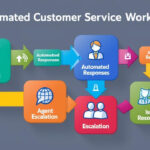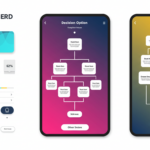
Decision trees are sophisticated tools that can be utilized within customer service departments to facilitate agents’ navigation through complex interactions. They stand apart from traditional agent script or static scripts due to their dynamic nature. As a conversation with a customer unfolds, decision trees adjust in real-time, providing tailored guidance that suits the specific context of each individual interaction. This dynamic adaptation means agents aren’t just reciting pre-written responses; they’re offered a roadmap of potential answers and actions based on the current conversation’s direction.
These tools work by branching out like a tree, with each customer response or data point leading to a new branch of potential actions or responses. This branching mechanism ensures that the guidance provided is highly relevant to the present situation. Decision trees can incorporate various types of customer information and interaction history, allowing for a level of personalization in service that static scripts are just not able to match.
This dynamic adaptation means agents aren’t just reciting pre-written responses
Moreover, decision trees empower agents by giving them quick access to information and decision paths, reducing the time spent searching for answers or escalating issues. They also reduce the cognitive load on agents, allowing them to focus more on the human aspect of customer service – empathy, understanding, and connection. This leads to more effective problem-solving, higher customer satisfaction, and increased efficiency in handling queries.
In essence, decision trees are more than just guides; they are dynamic, intelligent systems that transform the customer service landscape by making interactions more efficient, personalized, and agent-friendly. They represent a significant advancement over traditional methods, offering a smarter way to navigate the complexities of customer service.
What Are Decision Trees?
Decision trees are advanced, interactive guides that help customer service agents navigate through complex customer interactions. Unlike static scripts, decision trees adapt dynamically to the conversation’s flow, providing agents with real-time guidance tailored to the specific context of each interaction. This approach not only ensures a more personalized customer experience but also equips agents with the tools to handle queries more efficiently and accurately.
Enhanced Agent Efficiency and Training
One of the most significant impacts of Decision trees is their ability to reduce agent onboarding and training time. New agents can quickly become proficient as they are guided through intricate customer interactions, reducing the learning curve and the need for extensive training. This efficiency not only saves time but also reduces operational costs for contact centers.
Improving First Call Resolution and Handling Time
With the aid of decision trees, agents are better equipped to resolve customer issues on the first call, a key metric known as First Call Resolution (FCR). By providing step-by-step guidance and surfacing relevant information at the right time, decision trees help in reducing the average handling time of calls. This leads to quicker resolutions, higher customer satisfaction, and increased efficiency in the contact center.
Boosting Agent Confidence and Retention
Handling customer queries can be daunting, especially for new agents. Decision trees act as a virtual assistant, augmenting the agent’s skills by presenting necessary information and decision paths during interactions. This support not only boosts agent confidence but also improves job satisfaction, contributing to lower turnover rates in an industry known for high attrition.
Ensuring Compliance and Consistency
In industries where compliance with regulations is critical, decision trees ensure that all interactions adhere to the necessary guidelines. By standardizing responses and processes, they help maintain consistency across different agents and interactions, reducing the risk of compliance breaches. The following article is dedicated to discussing compliance in contact centers
Integration with Existing Systems
Platforms like Process Shepherd seamlessly integrate decision trees with existing CRM and helpdesk tools. This integration ensures that agents have a unified view of customer data and interaction history, enabling them to make informed decisions and provide a cohesive customer experience.
Conclusion
Decision trees, as part of solutions like Process Shepherd, are significantly transforming customer service outcomes in contact centers. They streamline the training process, enhance the efficiency and confidence of agents, improve key performance metrics such as FCR and average handling time, and ensure compliance and consistency in customer interactions. While they are not a one-size-fits-all solution, their impact on modernizing and improving the quality of customer service is undeniable. As contact centers continue to evolve, the role of decision trees in shaping customer service strategies becomes increasingly vital.
Image by DALL-E










